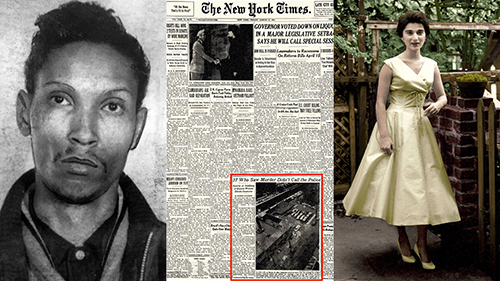“Would anybody remember or care about Kitty Genovese if she had been black?” That’s the very good question her just-deceased murderer, Winston Moseley, posed to me more than once in the scores of letters he wrote me.
I first wrote to Moseley in 2009, care of Clinton Correctional Facility in upstate Dannemora, where he was serving his life sentence for the notorious 1964 killing of Catherine (Kitty) Genovese. Moseley and I exchanged many letters in the years that followed, on topics ranging from his fluid memories and reflections on his crimes, to his feelings about his own family (particularly feelings of pride and guilt over his sons and his stalwart insistence that his own mother had been good to him), to his favorite books, movies and movie stars.
Moseley wasn’t terribly keen on me writing a book about Genovese. He told me as much in the first letter I received from him. It had been 45 years and he was bored by it all. He wanted to talk about things other than the murder that had earned him an ignominious place in history, and that was fine by me. My interest has always been in the minds and hearts of people rather than in the mechanics of the crimes they commit.
I asked him many questions about himself, and over time he became candid about his personal history. He also grew forthcoming about his opinions and ideas, which were intelligent if often self-serving.

Kitty Genovese in an undated photo
He was born in Harlem in 1935 and lived there until the age of 9, when his parents split up and he was sent to live on his maternal grandmother’s farm in Michigan. He attended high school in Detroit and lived there in his teen and early adult years.
He made a point of telling me that he found Detroit to be a very good place as far as race relations were concerned; he claimed he personally never encountered racism and always had white friends. For that matter, he said, he never personally experienced much racism in New York, either, writing that he had always felt employers had been fair with him and that he’d never been a victim of discrimination.
There was one area, however, where Moseley felt that racism had a pervasive and perpetual impact on his life as well as on the lives—and lost lives—of countless others. Moseley wasn’t usually inclined to say much about Genovese and his most infamous crime (and the only crime of his, in fact, for which he was ever prosecuted). But as he began to write more frankly about himself and his feelings, he revealed he’d long felt that society gives crime victims astonishingly disparate attention or respect on the basis of their skin color.
And yes, this is an awkward lesson to learn from a murderer.
How many killings had happened since 1964, he asked me, and how many of the victims had been black women and children? Where was the decades-long outrage, remembrance and scrutiny for any of the innumerable black murder victims? For that matter, where was the outrage and remembrance for Moseley’s other victims, the women he raped or killed prior to Genovese, all of whom had been black?
It’s certainly an oversimplification to say that Genovese’s death is remembered and studied because she was white. The lore mostly rose up around the reports that an entire neighborhood stood by while a terrible thing happened.

Winston Moseley in 1964
Still, it’s worth a thought experiment: Would a black Kitty Genovese ever have become a symbol of anything?
At the time of his death on March 28, 2016, Moseley was the longest-serving inmate in the New York correctional system. He had consistently been turned down for parole, even though he was 80 years old at his final parole hearing in 2015. Moseley believed that if he hadn’t killed a white woman—a young, attractive white woman—he would have been freed years ago.
We cannot say whether or not this is so. But neither should we dismiss the speculation as nothing but a hollow, self-serving statement of a remorseless murderer.
It’s undeniable that black victims are typically overlooked by the mainstream media and culture. Why? Part of it may be identifying with the victim; we are more prone to identify with those who resemble ourselves—and whites are still a plurality in the U.S.

From a letter sent by Moseley to the author
But is there something deeper, a dis-identification if you will, with victims who don’t share our race? Worse yet, have we come to expect the disproportionate rate of black homicides, so much so that no single victim could be a symbol of anything more than just the grim reality of urban life?
This is the fear. I’m now writing a book about serial killer Joseph Christopher, known in upstate New York as the “22-Caliber Killer” and in Manhattan as the “Midtown Slasher.” Christopher claimed at least 18 victims in the 1980s in a horrifying spate of attacks. You’ve probably never heard of Joseph Christopher, though. All of his victims were black.



